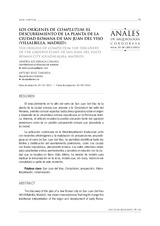Mostrar el registro sencillo del ítem
Los orígenes de Complutum: el descubrimiento de la planta de la ciudad romana de San Juan del Viso (Villalbilla, Madrid)
| dc.contributor.author | Azcárraga Cámara, Sandra | |
| dc.contributor.author | Ruiz Taboada, Arturo | |
| dc.date.accessioned | 2018-01-08T11:09:14Z | |
| dc.date.available | 2018-01-08T11:09:14Z | |
| dc.date.issued | 2013 | |
| dc.identifier.issn | 1130-9741 | |
| dc.identifier.uri | http://hdl.handle.net/10396/15791 | |
| dc.description.abstract | El descubrimiento en lo alto del cerro de San Juan del Viso de la planta de la ciudad romana que precede a la Complutum del valle del Henares, permite conocer aspectos hasta ahora ignorados sobre el origen y desarrollo de la urbanística romana republicana en la Península Ibérica. Además, el artículo muestra la posible ubicación tanto del oppidum prerromano como de un posible campamento romano que precedería a la ciudad. La aplicación combinada de la fotointerpretación tradicional junto con recientes ortoimágenes y la realización de prospecciones arqueológicas en el cerro de San Juan del Viso, ha permitido identificar tanto los límites y distribución del asentamiento prerromano, como una ciudad con trama hipodámica, plenamente romana. Los datos obtenidos sirven para caracterizar ambos asentamientos y ponerlos en relación con la ciudad que se localiza en llano. Esta última, ha servido de modelo para explicar la romanización en la zona, modelo que, sin duda, habrá de ser completado a partir de este momento. | es_ES |
| dc.description.abstract | The discovery of the plan of a new Roman city on San Juan del Viso hill (Villalbilla, Madrid), has shown new evidences that might change the traditional interpretation of the origin and development of early Romanization in the Henares valley. Until now, scholars have focused on the city of Complutum, at Henares valley, to explain such development. The city uphill has a Hippodamean plan and its foundation is related to a pre- Roman settlement, and the legionary fortress in close nearby. By using aerial photographs combined with orthophotos and archaeological surveys, we have identified the limits and distribution of these three settlements on the hill. The city of San Juan del Viso has a grid pattern with straight streets and rectangular several, different buildings and a theatre. The present work compares this settlement pattern uphill with the city of Complutum in order to understand the origin and development of Roman occupation in the centre of the Iberian Peninsula. This brings new light to the debate on early Romanization in this region; as a result, the conventional interpretation of Complutum should be reexamined. | es_ES |
| dc.format.mimetype | application/pdf | es_ES |
| dc.language.iso | spa | es_ES |
| dc.publisher | Universidad de Córdoba, Área de Arqueología | es_ES |
| dc.rights | https://creativecommons.org/licenses/by/3.0/ | es_ES |
| dc.source | Anales de Arqueología Cordobesa 23-24, 95-116 (2012-2013) | es_ES |
| dc.subject | San Juan del Viso | es_ES |
| dc.subject | Complutum | es_ES |
| dc.subject | Prospección | es_ES |
| dc.subject | Fotointerpretación | es_ES |
| dc.subject | Romanización | es_ES |
| dc.subject | San Juan del Viso's hill | es_ES |
| dc.subject | Archaeological suvegs | es_ES |
| dc.subject | Photointerpretation | es_ES |
| dc.subject | Romanization | es_ES |
| dc.title | Los orígenes de Complutum: el descubrimiento de la planta de la ciudad romana de San Juan del Viso (Villalbilla, Madrid) | es_ES |
| dc.title.alternative | The origins of Complutum: the discovery of the ground plant of San Juan del Viso’s Roman city (Guadalajara, Madrid) | es_ES |
| dc.type | info:eu-repo/semantics/article | es_ES |
| dc.relation.publisherversion | https://www.uco.es/ucopress/ojs/index.php/anarcor/index | es_ES |
| dc.rights.accessRights | info:eu-repo/semantics/openAccess | es_ES |

